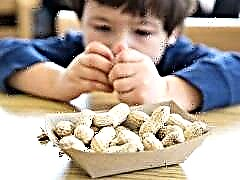
Nuts contain many useful substances, but their use in childhood has some limitations. Therefore, before treating a baby with any kind, it is worth learning about their benefits and dangers for the child's body, as well as the timing of the introduction of nuts into the diet of children recommended by doctors.

Benefit
- Any nut is a food with a high nutritional value. Added to the children's diet in small quantities, it will enrich it with many useful substances.
- They are a valuable source of natural oils, which contain polyunsaturated fatty acids. They are important for the normal functioning of the child's body and have a great impact on mental development. Almonds, hazelnuts, walnuts, and peanuts are especially rich in healthy fats. At the same time, walnuts will give the child and omega-3 fats.
- From them, children get vegetable proteins and fiber, so they are important for the diet of children who do not eat eggs and meat, and also have a beneficial effect on bowel function.
- They are a source of many vitamin compounds (primarily vitamin E, but they also contain other vitamins), as well as mineral salts (calcium, zinc and others), so their use is important for immunity and maintaining the health of the child's body. Hazelnuts are especially rich in vitamin E.
- Due to the combination of a fairly high calorie content, easily digestible fats and valuable plant proteins such a product is recommended for intensive physical activity.
- Brazil nut due to its high selenium content able to normalize blood glucose levels and help with skin diseases.
- Consuming walnuts can eliminate iodine deficiency. They have a positive effect on mental activity, and also help fight anemia and hypovitaminosis.
- Cashews contain a lot of iron, therefore they are recommended for anemia and frequent colds. They also have a positive effect on the health of the gums and teeth.
- Black walnut has an antihelminthic and antibacterial effect.
- Chopped nuts can replace flour, and are also often used to diversify the taste of familiar dishes, for example, for adding to a dessert or making a sauce.


Harm
Having learned how different types of nuts are useful, one should not forget about their possible harmful effects on the child's body.
They can be dangerous to children in the following situations.
They are classified as allergenic products that can cause severe and rapid allergic reactions (even when consumed in small quantities). This is the main reason why they should not be given to young children. An allergic reaction can occur to one type of nuts, but it also happens to several at once.
If an allergy has already appeared, it remains until the end of life and can be triggered not only by whole nuts, but also by oils (for example, if you add walnut oil to the dish), sweets or other products in the manufacture of which they are used.
- They may have individual intolerance, which manifests itself only in childhood, and when the child grows up, its symptoms disappear.
- Some types of nuts (for example, Brazilian or cashew nuts) are dangerous raw, so they must be fried.
- If they are stale and spoiled, they can cause food poisoning.
- Since they are considered rather difficult to digest, they are not advised to be given to children with diseases of the digestive tract.
- Since their calorie content is quite high, they should be limited in the diet of overweight children.
- Walnuts should not be given to children with exacerbations of gastrointestinal diseases, as well as with increased blood clotting.
- Excessive consumption of almonds is dangerous for children with diseases of the nervous system and arrhythmias.
- Hazelnuts should not be included in the diet of children with liver disease and diabetes.

At what age to give
Most doctors, including the popular pediatrician Komarovsky, recommend postponing acquaintance with nuts until the age of three, and some doctors advise giving them only over the age of 5 years. This is due to the fact that children under three years of age are more likely to react with an allergy to an unfamiliar product. In addition, a small child runs the risk of choking on nuts, because they are quite hard and small.
You can treat your baby with crushed nuts a little earlier (at 2 years old), if the crumbs do not have a tendency to allergies and the portion is small... At the same time, they cannot be given to a one-year-old child.

How to introduce into the diet
When offering any kind of nuts for the first time, limit yourself to one or even a part of it. It is best to treat a baby over 3 years old with one nut during breakfast in order to determine the tolerance of such a product during the day. If the child's well-being has not worsened, the stool is normal, there are no abdominal pains and no other manifestations of a negative reaction were found, the next time you can give two nuts, and with good tolerance, gradually increase the portion.

In what form to give
In order for the nuts to be absorbed better, it is advised to give them as a snack, as a separate dish. If they are not peeled, for example, inshell walnuts, peeling is recommended immediately before use. Nuts go well with dried fruits and honey - healthy sweets can be made from such a mixture for children (provided that there is no allergy to any of the components).

How much to give
To assess the daily rate for a particular baby, use the volume of his palm. A child can eat as many nuts per day as fits in his hand. In this case, you can give one type of nuts, but after getting to know all the types, it is preferable to treat the crumbs with a mixture of different varieties. The recommended frequency of eating nuts in childhood is 1-2 times a week.

How to choose
It is best to purchase nuts from the store, as the conditions in which they are in the market can lead to their deterioration (for example, exposure to the sun). Before giving the nut to your child, try it yourself. If the taste is unpleasant or rancid, discard them.
As for the choice of different varieties, consider the following features:
- Peanuts are the most common and inexpensive option, but they are considered the most allergenic. Although peanuts are legumes, they are classified as nuts for their properties. A child should not be given bags of salted roasted peanuts. It is best to choose an unpeeled nut for baby food, for example, in a shell, and then fry it in the oven and peel it yourself.
- Brazil nuts are also considered highly allergenic. In addition, they contain some dangerous substances for children, so their use is limited to 1-2 things per day.
- Very healthy and tasty walnuts are liked by most children for their unusual shape. When choosing them, it is important not to buy an overdried and rancid product, then it will only benefit. The optimal dose for children is considered 2 pieces per day.
- Many children are very fond of pine nuts because they are sweet and small in size. The cashew shape also attracts babies. Both of these varieties are usually bought peeled, so you should pay attention to the shelf life and appearance of the product.
- Hazelnut is a product available in our latitudes and has not only a lot of useful properties, but also a special taste. It is advised to buy it unpeeled, and if you bought hazelnuts without shells, store them for a maximum of six months.
- When choosing almonds for your child, buy only sweet varieties. If you want to purchase peeled almonds, they are preferable in packaging, as they are better protected from external influences than a product by weight. Don't buy wet, shriveled, or browned almonds. Also, skip the purchase if the surface is oily or moldy.
- Pecan is not recommended for children due to the high risk of allergies, but with good tolerance, it may well be included in the diet to replenish it with vitamins. When purchasing, make sure that the shell is clean and undamaged.
- When buying pistachios, pay attention to their appearance. Prefer open nuts with light shells and a green kernel. Take a closer look at the film between the kernel and the shell - it should be brown.
- When choosing inshell hazelnuts, make sure the shell is intact and odorless. Don't buy them if they are covered in spots or small dots.


For the benefits and dangers of nuts, see the following videos.
Find out if your child's weight is normal using the following calculator.



